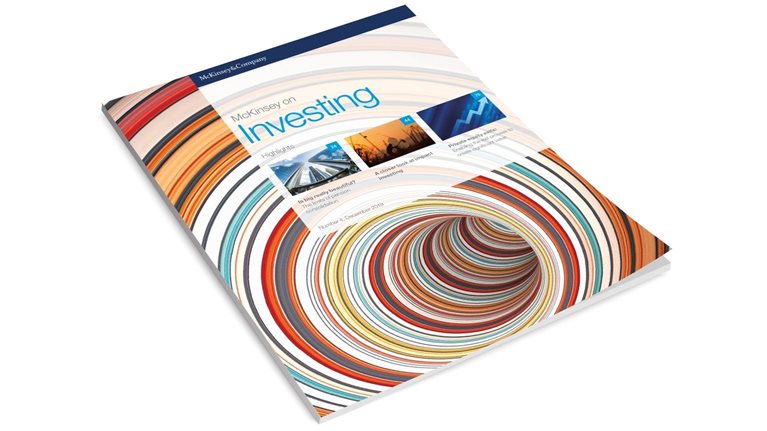After years of hype, anticipation, and steady uptake, the Internet of Things (IoT) seems poised to cross over into mainstream business use. The number of businesses that use the IoT technologies has increased from 13 percent in 2014 to about 25 percent today. And the worldwide number of IoT-connected devices is projected to increase to 43 billion by 2023, an almost threefold increase from 2018.1
Stay current on your favorite topics
This level of uptake is both a result and an impetus of the developing technologies that underpin the IoT. For one, technological advancement means that IoT technology will become easier to implement, opening the door for a wider variety of companies to benefit from IoT applications. Indeed, although large enterprises began to invest their sizable resources in IoT technologies years ago, the beneficiaries of this latest wave of IoT maturity will be small and medium-size enterprises. While they may not have the means to execute bespoke implementations, they can still invest in easy-to-use IoT solutions.
As frequent investors in midsize companies, private equity (PE) funds should re-evaluate the IoT as a sector that can help create significant value. To that end, this article will serve as an overview of the growing market for the IoT, the technology’s major applications, and the elements within the IoT technology stack. These insights can then be translated into business benefits for PE funds interested in becoming involved with the IoT as investors, owners, and partners.
Consistent growth
Advanced principal technologies and a proliferation of devices have helped fuel the growth of IoT technologies. In fact, investments in IoT technology are projected to grow at 13.6 percent per year through 20222 (see sidebar “Varied growth within the IoT depending on underlying technology”). Further growth in the coming years will be possible thanks to new sensors, more computing power, and reliable mobile connectivity.
Sensor technology—embedded in IoT devices—will continue to become cheaper, more advanced, and more widely available. In turn, this availability and cost-effectiveness will make new sensor applications possible, including large-scale monitoring and detection. Meanwhile, computing power has increased about 100 times in the past 15 years.3 Applications such as real-time analytics and artificial intelligence can thus shift activity from local devices toward cloud and edge computing solutions.4 In addition, improved mobile connectivity with the advent of 5G will allow new applications for experiences such as augmented and virtual reality.
Finally, the IoT market will grow because existing IT devices will need to be linked to the IoT. Growth in traditional connected IT devices is admittedly moderate—about 2 percent per year. However, the installed base of more than five billion smartphones, two billion personal computers, and one billion tablets indicates a massive market for device integration.5
Wide applications
The IoT already numbers more than 200 known applications in enterprise settings, but IoT adoption isn’t limited to large companies.6 And early adopters have moved beyond pilots to scale IoT solutions across their businesses. Indeed, IoT technologies have already given rise to a number of landmark applications in sectors as diverse as Industry 4.0, smart cities, smart homes, connected cars, and e-health. Furthermore, advances in the technologies that contribute to the IoT mean that all affected sectors can now access functionality that did not exist five years earlier. For instance, B2B companies have started using Industry 4.0 technologies to maintain direct connections to their products in the field. This constant monitoring makes predictive maintenance possible and improves efficiency and equipment uptime (see sidebar “IoT solutions at two private equity–owned companies”).
Significant market opportunities
The IoT technology stack has advanced over the past five years—in the meantime, each layer holds significant market growth opportunities. Device-enablement platforms have an especially strategic advantage of enabling related IoT growth while still in their own growth phase.
Would you like to learn more about our Private Equity & Principal Investors Practice?
Smart devices—the foundational layer of the IoT technology stack and the most mature product category—are dominated by large manufacturers and specialist suppliers and enjoy healthy market growth (Exhibit 1).

The connectivity layer of the IoT technology stack is most tightly bound to mobile-network operators that offer standard cellular connectivity. A small number of well-financed start-ups have targeted this layer of the stack and have made progress in subsegments such as low-power wide-area connectivity. Connectivity technology occupies a still-growing market that’s strongly influenced by international standardization in this technology layer.
In the third layer of the stack is cloud computing (which facilitates central processing and storage of data) and enablement platforms (which facilitate access to devices, data across devices, and connectivity standards). Complementary analytics and computational tools have emerged to interpret, visualize, and produce insights from device data. Together, these platforms have proliferated and developed over the past five years and now simplify device integration and application implementation—a favorable growth outlook for key players.
The final and top layer, business applications, will continue to be highly fragmented, with many disparate solutions and established companies coexisting with significant start-up activity. Because of its relatively early life, the largest IoT financial opportunities will likely come from this layer of the stack. However, cloud computing and device-enablement platforms will also be technologically and financially important.
Progress in cloud computing
Cloud platforms, the hardware and operating environments of web-based data centers, developed quickly over the past half-decade and now grow at a CAGR of 18 percent.7 During that time, large technology providers contributed their data-storage capacity and computing power as crucial fuel for the growth of IoT applications, which helped create numerous sophisticated functionalities for security and analytics. These functionalities were aided by strategic, technical partnerships between providers of specialized services that further augmented the value of cloud computing. For instance, a provider of cloud infrastructure might partner with a supplier of analytics solutions. In that vein, advances such as mobile edge computing (which reduces network congestion and improves application performance) can make IoT solutions easier to implement and use.
Importance of device-enablement platforms
Device-enablement platforms—connecting devices, cloud providers, and applications for optimal processing in IoT settings—are a notable source of growth and value.8 In a nutshell, device-enablement platforms improve financial performance across cost, revenue, and operating efficiency, especially for midmarket companies (see sidebar “Applications of device-enablement platforms”). These platforms’ ease of implementation helps midmarket companies take advantage of IoT opportunities, even as these companies have fewer resources for bespoke solutions compared with major enterprises.

Private markets come of age
Our research indicates that as device-enablement platforms become more important, in part due to uptake among small-to-medium-sized enterprises and small- and home-office users, their corresponding revenue pools will continue to grow at an average CAGR of 24 percent, 48 percent for the IoT use cases (Exhibit 2).

The majority of the device-enablement value pool is based in the Americas, where it was worth €5.5 billion in 2018. Device enablement’s importance to the IoT and its global revenue growth also means that both technological and business opportunities will be almost geography-agnostic and grow at similar rates. And although enterprise customers will remain the largest customer segment, device-enablement platforms will see fast uptake among small and mid-sized customers.
The growing market for IoT technology reflects some of the ways in which maturing technologies have begun to fulfill the promises of the IoT. PE funds should evaluate opportunities to leverage IoT in their portfolio companies and look for emerging investment opportunities in both the IoT market and in sectors that can reap outsized benefits from these technologies.

